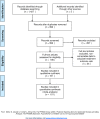Factors predictive of the success of tuberculosis treatment: A systematic review with meta-analysis
- PMID: 31881023
- PMCID: PMC6934297
- DOI: 10.1371/journal.pone.0226507
Factors predictive of the success of tuberculosis treatment: A systematic review with meta-analysis
Abstract
Objective: To produce pooled estimates of the global results of tuberculosis (TB) treatment and analyze the predictive factors of successful TB treatment.
Methods: Studies published between 2014 and 2019 that reported the results of the treatment of pulmonary TB and the factors that influenced these results. The quality of the studies was evaluated according to the Newcastle-Ottawa quality assessment scale. A random effects model was used to calculate the pooled odds ratio (OR) and 95% confidence interval (CI). This review was registered in the International Prospective Register of Systematic Reviews (PROSPERO) in February 2019 under number CRD42019121512.
Results: A total of 151 studies met the criteria for inclusion in this review. The success rate for the treatment of drug-sensitive TB in adults was 80.1% (95% CI: 78.4-81.7). America had the lowest treatment success rate, 75.9% (95% CI: 73.8-77.9), and Oceania had the highest, 83.9% (95% CI: 75.2-91.0). In children, the success rate was 84.8% (95% CI: 77.7-90.7); in patients coinfected with HIV, it was 71.0% (95% CI: 63.7-77.8), in patients with multidrug-resistant TB, it was 58.4% (95% CI: 51.4-64.6), in patients with and extensively drug-resistant TB it was 27.1% (12.7-44.5). Patients with negative sputum smears two months after treatment were almost three times more likely to be successfully treated (OR 2.7; 1.5-4.8), whereas patients younger than 65 years (OR 2.0; 1.7-2.4), nondrinkers (OR 2.0; 1.6-2.4) and HIV-negative patients (OR 1.9; 1.6-2.5 3) were two times more likely to be successfully treated.
Conclusion: The success of TB treatment at the global level was good, but was still below the defined threshold of 85%. Factors such as age, sex, alcohol consumption, smoking, lack of sputum conversion at two months of treatment and HIV affected the success of TB treatment.
Conflict of interest statement
The authors have declared that no competing interests exist.
Figures





References
-
- World Health Organization. Global tuberculosis report 2018. In. Geneva, Swizerland: WHO; 2018.
-
- World Health Organization. WHO End TB Strategy [Internet]. 2015. Available from: www.who.int/tb/post2015_strategy/en/
-
- World Health Organization. Global Health Observatory data repository [Internet]. Treatment coverage Data by WHO region. 2019. Available from: https://apps.who.int/gho/data/view.main.57056ALL
-
- Wells GA, Shea B, O’Connell D, Peterson J, Welch V, Losos M et al. The Newcastle-Ottawa Scale (NOS) for assessing the quality if nonrandomized studies in meta-analyses [Internet]. The Ottawa Hospital—Research Institute. 2009. Available from: http://www.ohri.ca/programs/clinical_epidemiology/oxford.asp
Publication types
MeSH terms
LinkOut - more resources
Full Text Sources
Medical
Miscellaneous

